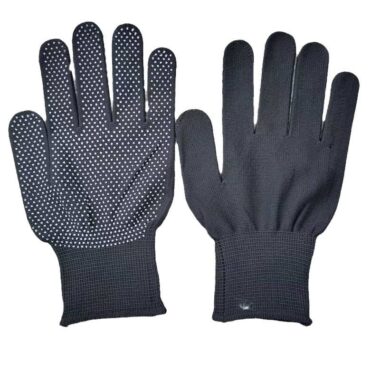When it comes to handling chemicals and hazardous materials, choosing the right work gloves is crucial for both safety and comfort. The ideal gloves provide a balance between chemical resistance, durability, dexterity, and comfort to protect workers from toxic substances, abrasions, and other industrial hazards. Here’s a guide to the best work gloves for these high-risk tasks:
1. Nitrile Gloves
Nitrile is one of the best materials for handling chemicals. Nitrile gloves offer:
- Chemical Resistance: They resist a wide range of chemicals, including oils, acids, and solvents. They provide an effective barrier against harmful substances, making them ideal for environments where workers deal with chemicals like paint thinners, oils, and industrial cleaners.
- Puncture Resistance: Nitrile is also more puncture-resistant than latex or vinyl, which adds an extra layer of safety when working with sharp objects.
- Dexterity: These gloves offer excellent flexibility and a snug fit, which is important for tasks that require fine motor skills.
- Latex-Free: Ideal for individuals with latex allergies.
2. Butyl Rubber Gloves
Butyl rubber is a synthetic rubber that offers:
- Exceptional Chemical Resistance: These gloves provide excellent protection against highly toxic chemicals, including ketones, esters, and highly concentrated acids.
- Durability: They are highly resistant to wear and tear, which makes them suitable for harsh environments where exposure to aggressive chemicals is common.
- Limited Abrasion Resistance: Butyl gloves are better suited for chemical handling but are less durable against abrasion compared to nitrile gloves. They may not be the best option if physical impact or rough handling is common.
3. Viton Gloves
Viton gloves are made from a high-performance fluoroelastomer material:
- Superior Chemical Resistance: They provide excellent resistance against aggressive chemicals like aromatic hydrocarbons, strong acids, and solvents (such as acetone or benzene).
- High Durability: Viton gloves are tough and can withstand a variety of hazardous chemicals for prolonged periods.
- Resistance to High Temperatures: These gloves can also withstand high heat, making them ideal for environments that involve both chemicals and high temperatures.
4. PVC (Polyvinyl Chloride) Gloves
PVC gloves offer:
- Chemical Resistance: PVC gloves provide good protection against acids, bases, and alcohols, making them suitable for tasks like cleaning, handling detergents, or light chemical handling.
- Water and Oil Resistance: They perform well in wet and oily environments, offering waterproof protection.
- Cost-Effective: PVC gloves are generally more affordable than nitrile or rubber options, though they might offer less flexibility and durability.
5. Neoprene Gloves
Neoprene is a versatile synthetic rubber with excellent chemical resistance:
- Resistant to Oils, Acids, and Bases: Neoprene gloves are a good choice when handling industrial chemicals, oils, fats, or caustic substances like sodium hydroxide.
- Comfort and Flexibility: They offer good dexterity and flexibility, making them suitable for tasks requiring fine manipulation.
- Moderate Temperature Resistance: They offer some resistance to heat and cold, although they are not as heat-resistant as Viton or butyl gloves.
6. Kevlar®-Lined Gloves (for Cut and Chemical Resistance)
If you need a glove that protects against both chemical exposure and cuts or abrasions, a Kevlar®-lined glove might be the right choice:
- Cut Resistance: Kevlar® fibers are extremely strong and resistant to cuts and abrasions, providing additional protection when working with sharp objects in hazardous environments.
- Chemical Resistance: Many Kevlar®-lined gloves also feature an outer layer of nitrile, latex, or PVC, providing a dual layer of chemical protection and mechanical strength.
7. Latex Gloves (for Non-Hazardous Chemicals)
While latex gloves are often used in light industrial settings:
- Chemical Resistance: They offer good resistance to water-based chemicals and mild acids but are not the best choice for more aggressive chemicals like solvents.
- Comfort and Dexterity: Latex provides excellent tactile sensitivity and comfort for tasks that require high dexterity.
- Risk of Allergies: Latex gloves can trigger allergies in some individuals, so this material is not ideal in workplaces where multiple workers have latex sensitivities.
8. Leather Gloves (for Chemical Handling with Mechanical Hazards)
In situations where workers need protection from both chemicals and physical hazards (like cuts or abrasions), leather gloves with chemical-resistant coatings are often used:
- Durability: Leather is tough and abrasion-resistant, providing excellent protection in environments where workers are handling both chemicals and rough, sharp objects.
- Chemical Resistance: When coated with a protective layer (like nitrile or PVC), leather gloves can offer both mechanical and chemical protection.
Key Considerations When Choosing Chemical-Resistant Gloves:
- Chemical Compatibility: Ensure that the glove material is compatible with the chemicals being handled. Each type of glove offers resistance to different types of chemicals, so always check the manufacturer’s chemical resistance chart.
- Dexterity: Choose gloves that provide a balance between protection and comfort. Some jobs require a high level of dexterity, so thinner gloves like nitrile may be ideal, while others may need thicker, more durable gloves for extra protection.
- Glove Fit: Proper fit is essential for safety and comfort. Gloves that are too loose can lead to a loss of grip or cause accidents, while tight gloves can impair movement and cause discomfort.
- Durability: The durability of the gloves depends on the work environment. For example, jobs involving a lot of physical handling might require thicker gloves, while jobs requiring fine precision may need more flexible gloves.
- Temperature Resistance: Some chemicals generate heat or are used in high-temperature environments. Consider gloves that offer heat resistance if you’re working with hot chemicals or equipment.
Conclusion:
The best gloves for handling chemicals and hazardous materials depend on the specific substances you’re working with. Nitrile gloves are an all-around great choice due to their versatility and high chemical resistance. For extremely hazardous chemicals, butyl or Viton gloves provide superior protection, while Kevlar®-lined gloves offer extra cut resistance for tasks involving sharp objects. Ultimately, ensure that the gloves are well-suited to your specific work environment and hazards.






















